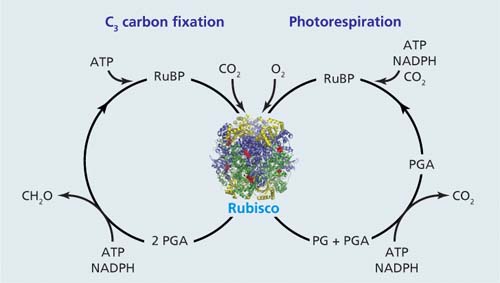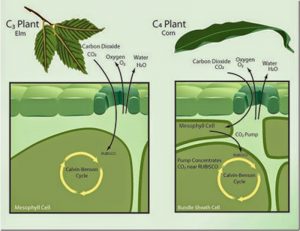It is well known that plants photosynthesize and use carbon dioxide to produce energy and oxygen. But did you know that different photosynthetic pathways might have a huge impact on how plants will react to climate change?
This is all based around the inefficiency of standard, so called C3 photosynthesis. Because photosynthesis evolved during a period of higher atmospheric CO2, the main enzyme responsible for turning CO2 into sugars, Rubisco, produces an intermediate product that likes reacting with oxygen (Andrews & Lorimer, 1987). This reaction, called photorespiration, releases CO2 again rather than turning it into a sugar and means it has no useful function. This wastes enzyme capacity and energy (ATP) that could be used for photosynthesis (Ehleringer , et al., 1991). This whole problem makes you think that surely nature must have found a way around this inefficiency.

And in fact it did: At a time of lower CO2 concentrations in the Earth’s history, flowering plants evolved a chemical pathway that increases the CO2 concentration within the cells of leafs through an intermediate step involving 4-carbon acids and increases Rubisco efficiency as well as water and nitrogen use (Ehleringer, et al., 1991)! These C4 plants dominate tropical and temperate grasslands and also include crops such as maize and sugar cane (Paul & Elmore, 1984), but only contribute about 20% of global primary production (Wand, et al., 1999).

However, climate change and increasing CO2 levels in the atmosphere from fossil fuel emissions might render this current advantage worthless. While low CO2 favours C4 plants, high CO2 levels increase the biomass of C3 plants (Pearcy & Ehleringer, 1984). And while increasing temperature further reduces the CO2 uptake of Rubisco in C3 plants, doubling ambient CO2 concentrations, something predicted to happen in the next 50 to 100 years, would cut photorespiration in half (Ehleringer, et al., 1991). C4 photosynthesis on the other hand might reach a saturation point above ambient CO2 levels and generally has a lower maximum production due to energy demand during the additional chemical pathway (Ehleringer, et al., 1991).
As with all processes in nature, this viewpoint may be too simplistic. Increasing CO2 concentration also results in a positive response in C4 plants, especially in conditions where they are already common (Sage & Kubien, 2003). Additionally, rising temperatures may favour C4 plants and their higher nitrogen use efficiency might reduce effects of future nutrient limitations coupled with high CO2 levels (Sage & Kubien, 2003). Generally, C4 plants are predicted to be unaffected by environmental stress, while the stimulation of C3 photosynthesis under increased CO2 is reduced under stress, especially nutrient limitation (Wand, et al., 2003).
It is obvious that C3 and C4 plants differ in their responses to climate change and will prosper in different parts of the globe with major potential influences on the distribution of each photosynthetic type. But overall, differences in this specific reaction are not the only reason for these distinct responses and further research must show how we can use these to counteract effects of climate change.
References
Andrews, T. J., & Lorimer, G. H. (1987). The Biochemistry of Plants, edited by MD Hatch & NK Bordman.
Bloom, A. (2009). As carbon dioxide rises, food quality will decline without careful nitrogen management. California Agriculture, 63(2), 67-72.
Ehleringer, J. R., Sage, R. F., Flanagan, L. B., & Pearcy, R. W. (1991). Climate change and the evolution of C4 photosynthesis. Trends in Ecology & Evolution, 6(3), 95-99.
Paul, R., & Elmore, C. D. (1984). Weeds and the C4 syndrome. Weeds Today, 15(1), 3-4.
Pearcy, R. W., & Ehleringer, J. (1984). Comparative ecophysiology of C3 and C4 plants. Plant, Cell & Environment, 7(1), 1-13.
Sage, R. F., & Kubien, D. S. (2003). Quo vadis C4? An ecophysiological perspective on global change and the future of C4 plants. Photosynthesis Research, 77(2-3), 209-225.
Wand, S. J., Midgley, G., Jones, M. H., & Curtis, P. S. (1999). Responses of wild C4 and C3 grass (Poaceae) species to elevated atmospheric CO2 concentration: a meta‐analytic test of current theories and perceptions. Global Change Biology, 5(6), 723-741.
[500 words]
Recent Comments